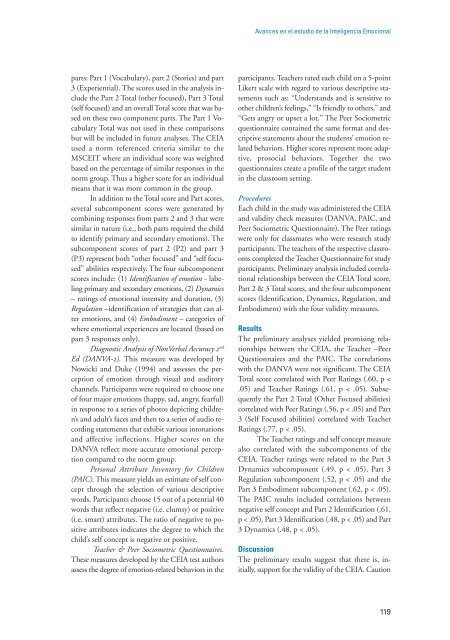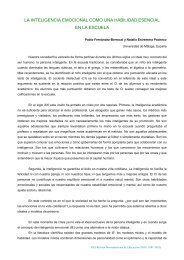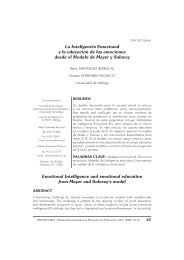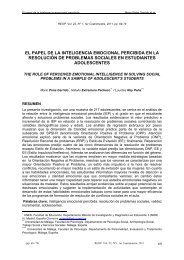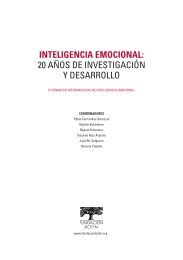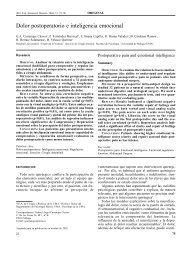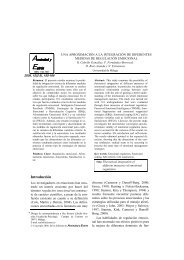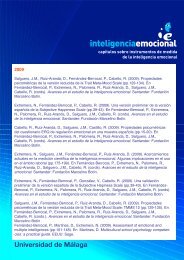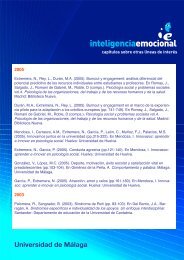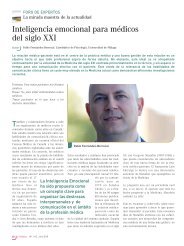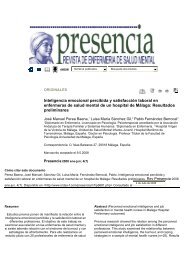Avances en el estudio de la Inteligencia Emocional
Avances en el estudio de la Inteligencia Emocional
Avances en el estudio de la Inteligencia Emocional
You also want an ePaper? Increase the reach of your titles
YUMPU automatically turns print PDFs into web optimized ePapers that Google loves.
<strong>Avances</strong> <strong>en</strong> <strong>el</strong> <strong>estudio</strong> <strong>de</strong> <strong>la</strong> Int<strong>el</strong>ig<strong>en</strong>cia <strong>Emocional</strong><br />
parts: Part 1 (Vocabu<strong>la</strong>ry), part 2 (Stories) and part<br />
3 (Experi<strong>en</strong>tial). The scores used in the analysis inclu<strong>de</strong><br />
the Part 2 Total (other focused), Part 3 Total<br />
(s<strong>el</strong>f focused) and an overall Total score that was based<br />
on these two compon<strong>en</strong>t parts. The Part 1 Vocabu<strong>la</strong>ry<br />
Total was not used in these comparisons<br />
but will be inclu<strong>de</strong>d in future analyses. The CEIA<br />
used a norm refer<strong>en</strong>ced criteria simi<strong>la</strong>r to the<br />
MSCEIT where an individual score was weighted<br />
based on the perc<strong>en</strong>tage of simi<strong>la</strong>r responses in the<br />
norm group. Thus a higher score for an individual<br />
means that it was more common in the group.<br />
In addition to the Total score and Part scores,<br />
several subcompon<strong>en</strong>t scores were g<strong>en</strong>erated by<br />
combining responses from parts 2 and 3 that were<br />
simi<strong>la</strong>r in nature (i.e., both parts required the child<br />
to id<strong>en</strong>tify primary and secondary emotions). The<br />
subcompon<strong>en</strong>t scores of part 2 (P2) and part 3<br />
(P3) repres<strong>en</strong>t both “other focused” and “s<strong>el</strong>f focused”<br />
abilities respectiv<strong>el</strong>y. The four subcompon<strong>en</strong>t<br />
scores inclu<strong>de</strong>: (1) Id<strong>en</strong>tification of emotion - <strong>la</strong>b<strong>el</strong>ing<br />
primary and secondary emotions, (2) Dynamics<br />
– ratings of emotional int<strong>en</strong>sity and duration, (3)<br />
Regu<strong>la</strong>tion –id<strong>en</strong>tification of strategies that can alter<br />
emotions, and (4) Embodim<strong>en</strong>t – categories of<br />
where emotional experi<strong>en</strong>ces are located (based on<br />
part 3 responses only).<br />
Diagnostic Analysis of NonVerbal Accuracy 2 nd<br />
Ed (DANVA-2). This measure was <strong>de</strong>v<strong>el</strong>oped by<br />
Nowicki and Duke (1994) and assesses the perception<br />
of emotion through visual and auditory<br />
chann<strong>el</strong>s. Participants were required to choose one<br />
of four major emotions (happy, sad, angry, fearful)<br />
in response to a series of photos <strong>de</strong>picting childr<strong>en</strong>’s<br />
and adult’s faces and th<strong>en</strong> to a series of audio recording<br />
statem<strong>en</strong>ts that exhibit various intonations<br />
and affective inflections. Higher scores on the<br />
DANVA reflect more accurate emotional perception<br />
compared to the norm group.<br />
Personal Attribute Inv<strong>en</strong>tory for Childr<strong>en</strong><br />
(PAIC). This measure yi<strong>el</strong>ds an estimate of s<strong>el</strong>f concept<br />
through the s<strong>el</strong>ection of various <strong>de</strong>scriptive<br />
words. Participants choose 15 out of a pot<strong>en</strong>tial 40<br />
words that reflect negative (i.e. clumsy) or positive<br />
(i.e. smart) attributes. The ratio of negative to positive<br />
attributes indicates the <strong>de</strong>gree to which the<br />
child’s s<strong>el</strong>f concept is negative or positive.<br />
Teacher & Peer Sociometric Questionnaires.<br />
These measures <strong>de</strong>v<strong>el</strong>oped by the CEIA test authors<br />
assess the <strong>de</strong>gree of emotion-r<strong>el</strong>ated behaviors in the<br />
participants. Teachers rated each child on a 5-point<br />
Likert scale with regard to various <strong>de</strong>scriptive statem<strong>en</strong>ts<br />
such as: “Un<strong>de</strong>rstands and is s<strong>en</strong>sitive to<br />
other childr<strong>en</strong>’s fe<strong>el</strong>ings,” “Is fri<strong>en</strong>dly to others,” and<br />
“Gets angry or upset a lot.” The Peer Sociometric<br />
questionnaire contained the same format and <strong>de</strong>scriptive<br />
statem<strong>en</strong>ts about the stud<strong>en</strong>ts’ emotion r<strong>el</strong>ated<br />
behaviors. Higher scores repres<strong>en</strong>t more adaptive,<br />
prosocial behaviors. Together the two<br />
questionnaires create a profile of the target stud<strong>en</strong>t<br />
in the c<strong>la</strong>ssroom setting.<br />
Procedures<br />
Each child in the study was administered the CEIA<br />
and validity check measures (DANVA, PAIC, and<br />
Peer Sociometric Questionnaire). The Peer ratings<br />
were only for c<strong>la</strong>ssmates who were research study<br />
participants. The teachers of the respective c<strong>la</strong>ssrooms<br />
completed the Teacher Questionnaire for study<br />
participants. Pr<strong>el</strong>iminary analysis inclu<strong>de</strong>d corr<strong>el</strong>ational<br />
r<strong>el</strong>ationships betwe<strong>en</strong> the CEIA Total score,<br />
Part 2 & 3 Total scores, and the four subcompon<strong>en</strong>t<br />
scores (Id<strong>en</strong>tification, Dynamics, Regu<strong>la</strong>tion, and<br />
Embodim<strong>en</strong>t) with the four validity measures.<br />
Results<br />
The pr<strong>el</strong>iminary analyses yi<strong>el</strong><strong>de</strong>d promising r<strong>el</strong>ationships<br />
betwe<strong>en</strong> the CEIA, the Teacher –Peer<br />
Questionnaires and the PAIC. The corr<strong>el</strong>ations<br />
with the DANVA were not significant. The CEIA<br />
Total score corr<strong>el</strong>ated with Peer Ratings (.60, p <<br />
.05) and Teacher Ratings (.61, p < .05). Subsequ<strong>en</strong>tly<br />
the Part 2 Total (Other Focused abilities)<br />
corr<strong>el</strong>ated with Peer Ratings (.56, p < .05) and Part<br />
3 (S<strong>el</strong>f Focused abilities) corr<strong>el</strong>ated with Teacher<br />
Ratings (.77, p < .05).<br />
The Teacher ratings and s<strong>el</strong>f concept measure<br />
also corr<strong>el</strong>ated with the subcompon<strong>en</strong>ts of the<br />
CEIA. Teacher ratings were r<strong>el</strong>ated to the Part 3<br />
Dynamics subcompon<strong>en</strong>t (.49, p < .05), Part 3<br />
Regu<strong>la</strong>tion subcompon<strong>en</strong>t (.52, p < .05) and the<br />
Part 3 Embodim<strong>en</strong>t subcompon<strong>en</strong>t (.62, p < .05).<br />
The PAIC results inclu<strong>de</strong>d corr<strong>el</strong>ations betwe<strong>en</strong><br />
negative s<strong>el</strong>f concept and Part 2 Id<strong>en</strong>tification (.61,<br />
p < .05), Part 3 Id<strong>en</strong>tification (.48, p < .05) and Part<br />
3 Dynamics (.48, p < .05).<br />
Discussion<br />
The pr<strong>el</strong>iminary results suggest that there is, initially,<br />
support for the validity of the CEIA. Caution<br />
119


